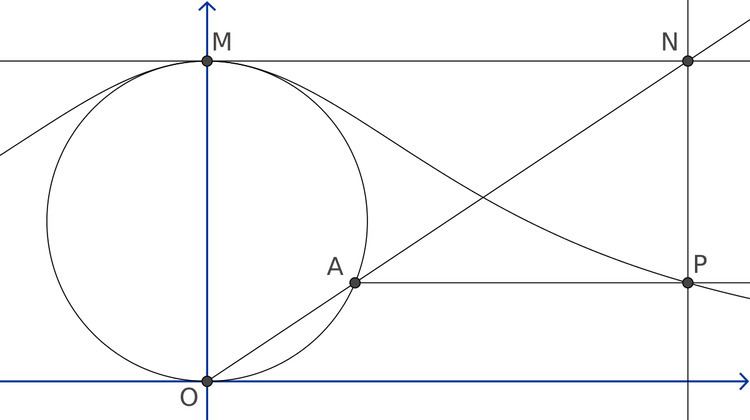 | ||
In mathematics, the Witch of Agnesi ([a.ˈɲe.zi]), sometimes called the "Witch of Maria Agnesi" is the curve defined as follows.
Contents
Starting with a fixed circle, a point O on the circle is chosen. For any other point A on the circle, the secant line OA is drawn. The point M is diametrically opposite to O. The line OA intersects the tangent of M at the point N. The line parallel to OM through N, and the line perpendicular to OM through A intersect at P. As the point A is varied, the path of P is the Witch of Agnesi.
The curve is asymptotic to the line tangent to the fixed circle through the point O.
Equations
Suppose the point O is the origin, and that M is on the positive y-axis. Suppose the radius of the circle is a.
Then the curve has Cartesian equation
Note that if a = 1/2, then this equation becomes rather simple:
This is the derivative of the arctangent function.
Parametrically, if θ is the angle between OM and OA, measured clockwise, then the curve is defined by the equations
Another parameterization, with θ being the angle between OA and the x-axis, increasing anti-clockwise is
Properties
The following properties can be derived from integral calculus.
History
The curve was studied by Pierre de Fermat in 1630. In 1703, Guido Grandi gave a construction for the curve. In 1718 Grandi suggested the name versoria for the curve, the Latin term for sheet, the rope which turns the sail, and used the Italian word for it, versiera, a hint to sinus versus that appeared in his construction.
In 1748, Maria Gaetana Agnesi published her summation treatise Instituzioni analitiche ad uso della gioventù italiana, in which the curve was named according to Grandi, versiera. Coincidentally, the contemporary Italian word avversiera or versiera, derived from Latin adversarius, a nickname for Devil, "Adversary of God", was synonymous with "witch". Cambridge professor John Colson mistranslated the name of the curve thus. Different modern works about Agnesi and about the curve suggest slightly different guesses how exactly this mistranslation happened. Struik mentions that:
The word [versiera] is derived from Latin vertere, to turn, but is also an abbreviation of Italian avversiera, female devil. Some wit in England once translated it 'witch', and the silly pun is still lovingly preserved in most of our textbooks in English language. ... The curve had already appeared in the writings of Fermat (Oeuvres, I, 279–280; III, 233–234) and of others; the name versiera is from Guido Grandi (Quadratura circuli et hyperbolae, Pisa, 1703). The curve is type 63 in Newton's classification. ... The first to use the term 'witch' in this sense may have been B. Williamson, Integral calculus, 7 (1875), 173; see Oxford English Dictionary.
On the other hand, Stephen Stigler suggests that Grandi himself "may have been indulging in a play on words".
Application
The witch of Agnesi approximates the spectral energy distribution of spectral lines, particularly X-ray lines.
Formally, the curve is equivalent to the probability density function of the Cauchy distribution.
The cross-section of a smooth hill also has a similar shape. It has been used as the generic topographic obstacle in a flow in mathematical modeling.
